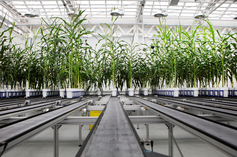Impact success story: Plant biotechnology
The discovery of how to genetically modify plants is a classic example of how curiosity-driven research can lead to important scientific breakthroughs. In addition to new applications in agriculture, this new technology has also made important achievements in fundamental and applied research possible.
Throughout the world, scientists are committed to deciphering the molecular mechanisms and life processes of viruses, bacteria, plants, animals and humans. Insights into growth and disease mechanisms in plants can help to increase the yield of agricultural crops, prevent damage from pests and diseases, or protect crops against extreme conditions such as drought.

The breeding sector has embraced genome editing for many reasons. Genome editing is also very useful in that it allows producers to easily introduce genetic variation into their crops, which is the starting point for any form of breeding. They can do this without adding genes from other organisms - something that has fuelled resistance to GM crops in some regions.
A quick look back in time
In the late 1970s, researchers at Ghent University led by professors Jeff Schell† and Marc Van Montagu worked with the soil bacterium Agrobacterium tumefaciens. This bacterium infects plants in nature and causes a kind of tumour, the so-called ‘crown gall disease’.
Scientists were looking for the ‘tumour-inducing principle’ of the bacterium. They wondered how Agrobacterium stimulated the plant to form crown gall tumours. It turned out that the bacterium transfers a piece of its own genetic material to the DNA of the plant. This DNA was found to be on a plasmid, which was named ‘Ti plasmid’ (Tumour-inducing plasmid). The transferred DNA induces uncontrolled cell division and stimulates the cells to produce substances that the bacterium can feed on. In other words, the bacterium obliges the plant to make its food.
Schell and Van Montagu immediately realised that they had found a postman who would allow them to genetically modify plants. The plant could be given an extra characteristic by replacing the piece of bacterial DNA that is normally transferred to the plant with another piece of DNA.
And, even today, the Agrobacterium-based method is still the most used and most efficient way to genetically adapt plants. Ghent University can therefore legitimately be regarded as the birthplace of plant biotechnology. This pioneering work was the start of a new era of plant science and plant modification.
In 2013 Van Montagu received the World Food Prize for his important role in the development of green biotechnology. In his research, he was driven to find new ways to feed the growing world population.
“As a researcher you have to keep doubting,” says Van Montagu. “Do research and then do even more, but realise that what you will find may be different than what you originally expected. This uncertainty doesn’t inspire trust in people, but we can’t wait either. We live in today’s world, and that’s where the problems are. Take the problem of overpopulation, for example: we’re now able to produce enough food, but there are still many people who only have poor quality food. People blame science and technology. That’s not right. Certainly as far as plants are concerned, we can take enormous steps forward, in a manner comparable to the progress made in medical science. Now that we have the CRISPR-Cas technology, we can modify plants in highly specific ways.”
Continued tradition
A new generation of researchers has now taken over the work of Schell and Van Montagu and is pushing the boundaries in their own way. Under the leadership of professor Dirk Inzé, the VIB-Ghent University Centre for Plant Systems Biology has grown into one of the best research centres in plant biotechnology in the world.
“Plants have around 30,000 genes. Each gene is a small building block with a specific function. We focus here on research into the growth and shape of plants. We try to find out, among other things, which genes are responsible for growth. This won’t easy, because many genes come to play in a complex set of interactions. In other words, we try to understand that biological system.”